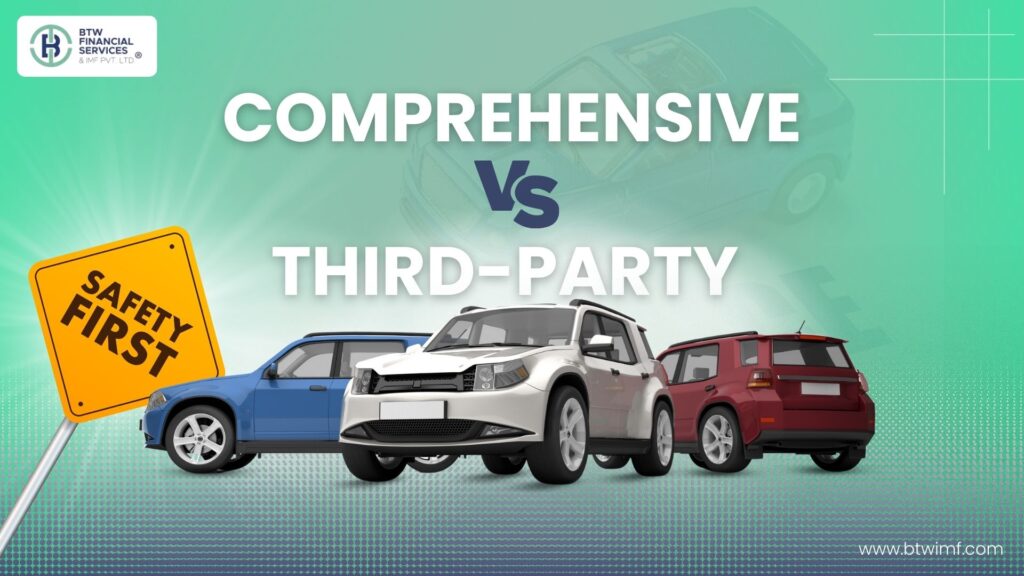Comprehensive vs. Third-Party Insurance: Picking the Right One for You
Summary:
- Comprehensive Insurance: Offers broad protection covering third-party damages, own vehicle damages, theft, natural disasters, and more. Ideal for: New/valuable vehicle owners, those seeking peace of mind, and high net worth individuals.
- Third-Party Insurance: Covers only third-party damages, meeting minimum legal requirements. Suitable for: Budget-constrained individuals, owners of low-value vehicles, and those prioritizing legal compliance over extensive coverage.
- Key Decision Factors: Vehicle value, financial situation, risk tolerance, and legal obligations.
- Actionable Step: Assess your needs, compare policies, and consider customization options to make an informed insurance choice.
Table Of Content
- Introduction to Vehicle Insurance
- Overview of Each Type
- 2.1 Third-Party Insurance
- 2.2 Comprehensive Insurance
- Key Considerations for Choosing the Right Insurance
- 3.1 For Third-Party Insurance
- 3.2 For Comprehensive Insurance
- Step-by-Step Decision Guide
- Detailed Comparison: Comprehensive vs. Third-Party Insurance
- 5.1 Coverage
- 5.2 Premium Costs
- 5.3 Customization Options
- 5.4 Claim Process
- 5.5 Legal Implications
- Scenario-Based Decision Making
- 6.1 New Vehicle Owners
- 6.2 Owners of Older Vehicles
- 6.3 Budget-Constrained Individuals
- 6.4 High Net Worth Individuals
- Additional Resources for Further Reading
- Conclusion
- Frequently Asked Questions (FAQs)
1. Introduction to Vehicle Insurance
Vehicle insurance is a crucial financial product designed to protect vehicle owners against financial losses in the event of accidents, theft, or damages. With various types of insurance available, understanding the nuances between them is vital for making an informed decision. This guide focuses on the two primary types: Comprehensive Insurance and Third-Party Insurance.
2. Overview of Each Type
2.1 Third-Party Insurance
- Definition: The most basic form of vehicle insurance, mandated by law in many countries to ensure drivers can cover the costs of damages to others in the event of an accident.
- Coverage Includes:
- Third-Party Property Damage: Covers costs for damages to other people’s property.
- Third-Party Medical Expenses: Includes costs for injuries to others.
- Death Benefits: Provides compensation in the event of a fatal accident.
- Own Vehicle Damage: NOT COVERED
- Premiums: Generally the cheapest option, as it offers the minimum required coverage.
- Mandatory: Yes, in most jurisdictions to ensure a basic level of financial responsibility.
2.2 Comprehensive Insurance
- Definition: Offers the widest range of protection, covering not only third-party damages but also your own vehicle against various risks.
- Coverage Includes:
- All Third-Party Coverage: Same as above.
- Own Vehicle Damage: Accidents, whether your fault or not.
- Theft: If your vehicle is stolen.
- Natural Disasters: Floods, earthquakes, etc.
- Vandalism: Intentional damages to your vehicle.
- Fire: Whether accidental or otherwise.
- Additional Benefits (Varies by Policy): Towing, car rentals, roadside assistance, etc.
- Premiums: More expensive due to the comprehensive nature of the coverage.
- Customization: Often allows for add-ons to enhance your protection further.
3. Key Considerations for Choosing the Right Insurance
3.1 For Third-Party Insurance
- Budget Constraint: Ideal if premiums are a significant concern.
- Older Vehicles: If the vehicle’s value is low, Comprehensive Insurance might not be cost-effective.
- Legal Requirement: For meeting the minimum legal standards with the least expense.
3.2 For Comprehensive Insurance
- New or Valuable Vehicles: Protects your significant investment.
- Financial Stability: If you can afford the premiums and seek peace of mind.
- Risk Tolerance: For those who prefer to mitigate all potential financial losses.
4. Step-by-Step Decision Guide
- Assess Vehicle Value: Determine if your vehicle’s worth justifies Comprehensive Insurance costs.
- Evaluate Financial Situation: Can you afford Comprehensive premiums? Do you have an emergency fund for unexpected damages if choosing Third-Party?
- Consider Risk Tolerance: How would you handle the financial impact of an uninsured event?
- Review Additional Coverage Needs: If you need protection against specific perils, Comprehensive might be necessary.
- Check Legal Requirements: Ensure you meet the minimum legal standards in your jurisdiction.
- Compare Policies: Research different insurers for both types, focusing on coverage, premiums, and customer service.
5. Detailed Comparison: Comprehensive vs. Third-Party Insurance
Coverage:
Comprehensive Insurance offers extensive coverage, including damages to your own vehicle, in contrast to Third-Party Insurance, which only covers damages to third-party property or persons. This means that with Comprehensive Insurance, you’re protected against a wide array of risks, including accidents, theft, natural disasters, vandalism, and fire, in addition to third-party damages.
On the other hand, Third-Party Insurance is limited to covering costs for third-party property damage, third-party medical expenses, and death benefits, without any protection for your own vehicle.
Premium Costs:
The cost of premiums significantly differs between the two types of insurance. Third-Party Insurance is generally the cheapest option, as it provides the minimum required coverage.
In contrast, Comprehensive Insurance is more expensive, with premiums reflecting the broader and more extensive coverage it offers. This higher cost is a trade-off for the peace of mind and financial protection that Comprehensive Insurance provides.
Customization Options:
When it comes to customization, Comprehensive Insurance often has the upper hand. Many insurers offer various add-ons for Comprehensive Insurance policies, allowing you to enhance your protection further based on your specific needs or concerns.
In contrast, customization options are typically limited with Third-Party Insurance, given its standardized, legally mandated nature.
Claim Process:
The process of filing a claim can also vary between the two. Claims for Third-Party Insurance are generally straightforward, focusing solely on third-party damages.
Comprehensive Insurance claims, however, can be more complex due to the comprehensive nature of the coverage. This might involve more documentation and assessment to cover damages to your own vehicle, in addition to any third-party claims.
Legal Implications:
Both types of insurance have legal implications, but they differ in scope. Third-Party Insurance meets the minimum legal requirements in most jurisdictions, ensuring you’re legally covered to drive.
Comprehensive Insurance, while not legally mandated beyond the third-party aspect, offers additional legal protection by covering your own vehicle, thereby reducing potential legal and financial liabilities in a broader range of scenarios.
6. Scenario-Based Decision Making
6.1 New Vehicle Owners
- Recommendation: Comprehensive Insurance to protect your new investment against all potential risks.
- Consideration: Budget for higher premiums or explore financing options that include insurance costs.
6.2 Owners of Older Vehicles
- Recommendation: Third-Party Insurance if the vehicle’s value is significantly low, or Comprehensive if the vehicle still holds considerable value or sentimental worth.
- Consideration: Weigh the cost of Comprehensive Insurance against the vehicle’s current market value.
6.3 Budget-Constrained Individuals
- Recommendation: Third-Party Insurance to meet legal requirements at the lowest cost.
- Consideration: Review and adjust your budget to potentially accommodate Comprehensive Insurance in the future.
6.4 High Net Worth Individuals
- Recommendation: Comprehensive Insurance for maximum protection of valuable vehicles.
- Consideration: Explore premium Comprehensive Insurance packages offering bespoke coverage options.
7. Additional Resources for Further Reading
- Insurance Regulatory Body Website (Country/Region Specific)
- Vehicle Insurance Comparison Websites
- Financial Planning and Advisory Services
- Vehicle Manufacturer Recommendations on Insurance
8. Conclusion
Choosing between Comprehensive and Third-Party Insurance requires careful consideration of several factors, including the value of your vehicle, your financial situation, risk tolerance, and legal obligations. While Comprehensive Insurance provides extensive coverage for your own vehicle as well as third-party damages, Third-Party Insurance only covers damages to others and is generally more affordable.
By evaluating your needs and using a step-by-step decision-making process, you can confidently choose the right policy for your situation. To ensure you make the best choice, it’s always a good idea to consult a licensed insurance provider who can guide you through the details and help you select the most suitable option.
Disclaimers: The above information is for reference purposes only: Policy Assurance and Claims at the underwriter’s discretion.
7. Frequently Asked Questions (FAQs)
Q: Is Third-Party Insurance enough for legal compliance?
A: Yes, in most jurisdictions, but always check local laws.
Q: Can I customize my Comprehensive Insurance?
A: Yes, most insurers offer add-ons for enhanced protection.
Q: What if I can only afford Third-Party Insurance but want more coverage?
A: Review your budget annually, and consider Comprehensive when financially viable.





